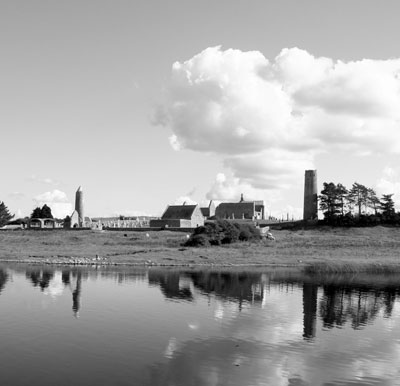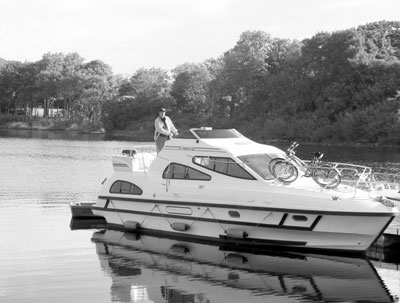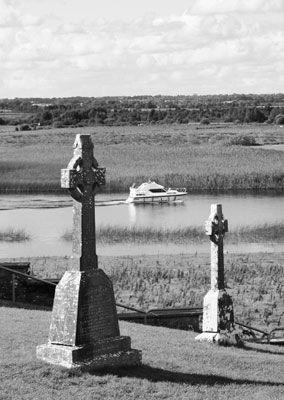Cruising up the Shannon through the 40 shades o’green
by Lew Toulmin (Second of two parts, jump to part 1, part 2)
Last month I described part of our September ’05 week-long, self-drive, Emerald Star/Crown Blue Line Shannon River cruise, taking us from the start at Portumna to Lough Derg and then north to Meelick. This month I describe the portion of the trip north along the Shannon and give some tips for first-time self-drive cruisers.
Onshore discoveries
Cruising north from the lock at Meelick about two hours, my wife, Susan, and I were amazed at the beautiful rural nature of the river. We had expected development and all its problems but instead were greeted with lovely rural fields, curious cows and a few relaxed horses along the banks of the gorgeous Shannon. The Irish have really gotten it right with their strict zoning and building codes, which prevent sprawl and preserve the rural countryside and way of life for locals and visitors alike.
Near dusk, we arrived at the charming town of Banagher and stopped for the night at the free dock on the eastern shore of the river. We walked through the town and chatted up some locals. They mainly talked about the high prices, confirming our impression that prices in Ireland were high by U.S. and even continental European standards.
This is the result of the success of the information technology-driven “Celtic Tiger,” which has given Ireland one of the highest per capita incomes and standards of living in the world — higher than those of the U.S. or U.K. by most measures. We were quite pleased that we were sleeping aboard our reasonably priced vessel and thus able to avoid expensive hotels ashore.
At Banagher we examined one of many fortifications left over from the Napoleonic period. This was a “Martello tower,” a round, squat fort with firing ports for cannons. During the Napoleonic Wars, the French threatened to invade Ireland on several occasions and the British authorities thought it wise to fortify all the Shannon villages, bridges and canals. It was amazing to encounter an anti-French fort 100 miles upriver from the mouth of the Shannon, but in those days the rivers and canals were much better invasion routes than the roads.
Clonmacnoise
The next morning we spent a few minutes on our daily ship’s maintenance chores: checking the engine oil, the radiator coolant level, the water intake filter and the bilgewater level. As usual, we needed to add a bit of water to the radiator; everything else was fine.
We then sailed north to Clonmacnoise, one of the premier religious centers in Ireland. It was established in about A.D. 545 by Saint Ciaran and seven followers. For 1,000 years it was the leading monastic center in Ireland, despite over 20 devastating raids by Vikings, Englishmen, Normans and Munstermen.
Although the monastery effectively closed in 1547 when it was stormed by English troops, there is still a lot to see at this fascinating site. There are two of the famous “round towers” — tall, narrow towers with their doors 10 to 15 feet in the air. The towers were used for storing monastic treasures and books, as bell towers and as hiding places during enemy raids.
Clonmacnoise is the burial place of Rory O’Conner, the last High King of Ireland, who died in 1198, and various other kings. The museum houses two spectacular 9-foot-high Irish high crosses — awesome examples of Celtic stonework.
Freedom to explore
North of Clonmacnoise, we followed the twisting river around curves and through many green fields to the lovely, historic town of Athlone, where we docked across from the imposing Athlone Castle. Here we paid €10 (about $12), the only time we paid for dockage on the whole trip.
We walked around the Old Town area and the waterfront. We found a convenient and very reasonably priced pub and Internet café (about $4 per hour for access), run by a tall Czech, where we checked our e-mail. Our host said that over 70,000 Poles, Czechs and other Eastern Europeans had come to Ireland in the last three years to live, lured by numerous job openings and high wages.
Departing Athlone, we cruised north along the Shannon, then entered Lough Ree, a 30-mile-long, beautiful, twisty, island-filled lake. The shores of the lake were almost entirely undeveloped, with green fields and even greener forests.
We steamed three hours north, keeping red buoys on the left and black on the right when headed upstream, the standard practice in the Republic of Ireland. Buoys appeared every half mile in the lough (and every few hundred yards on the river), so we were always sure of the channel location.
At Lough Ree we could have chosen to cruise around the lake or go explore some of the beguiling inlets shown on the map. That is one of the great things about self-drive cruising: you just look at the map, get advice from the boat rental firm and the locals and head out at your own pace. The freedom of self-drive cruising is quite extraordinary when compared with the regimented nature of most group tours ashore.
At Lanesborough, at the north end of the lake, we went ashore, bought some groceries, had a good craic (fun talk, pronounced “crack”) with some friendly residents and walked through the quiet, pretty town. We knew that the next day we could loop north for a mile or two but then would have to turn south and begin retracing our route toward our home port of Portumna.
Our week-long trip was almost over, but we didn’t want to turn back. We were keen to continue north as far as the origin of the river at the Shannon Pot and explore every Shannon tributary and side canal. No doubt about it — some Irish leprechauns had successfully beguiled us with those gorgeous 40 shades o’ green.
Tips for first-timers
Here are some tips for first-time, self-drive cruisers.
- Take along foul-weather gear in case the weather gets wet or windy.
- Test and learn all systems before leaving the dock. We had no problems except with the stove and cooktop, which were not hooked up tightly enough to the outboard gas bottle. An Irishman familiar with gas systems could have resolved this easily, but we had some difficulty.
- Choose a boat large enough to allow children, teens or other couples to get away from the rest of the crew if it is raining.
- Take your own high-quality zoom binoculars. Most boat rental firms supply basic binoculars, but these often have seen long usage. And if (and when!) there is something great to see, you will want more than one pair.
-
Take a high-SPF sunblock, mosquito repellent for the occasional local “midges,” sunglasses, a flashlight, and games and books appropriate to the age of your crew.
-
Practice maneuvering your boat in moderate winds as you dock and undock; motor boats have a lot of windage and this can making docking in high winds difficult. So practice up ahead of time.
- Learn at least one sailor’s knot: the clove hitch. You will use this often when tying up to cleats ashore.
- Don’t worry in advance — self-drive river cruising is much easier than driving a car. Have fun!
Hiring a motorboat
Emerald Star is represented across Europe and the U.S. by Crown Blue Line (980 Awald Rd., Ste. 302, Annapolis, MD 21403; call 800/992-0291, e-mail info@leboat.com or visit www.crownblueline.com). From Portumna, County Galway, south-central Ireland, a week-long voyage in an Emerald Star boat similar to ours will cost about $2,116 in fall 2006.
The Toulmins received from Crown Blue Line and Emerald Star complimentary use of the motorboat on their Shannon River voyage but paid for fuel costs (about $300) as well as meals and airfare.



